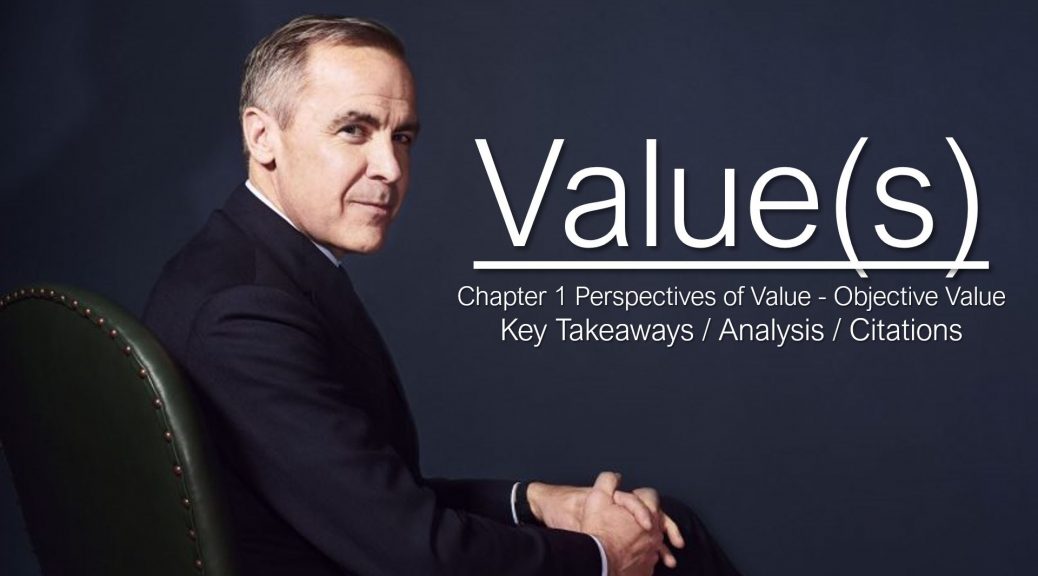Part 1 The Rise of the Market Society
Chapter 1 Perspectives of Value – Objective Value
Key Takeaways
The first two chapters of Value(s) cover objective value versus subjective value measurement:
Objective value is determined by the fixed and variable costs that go into production of the good or service. It’s the idea that the underlying value is determined not by demand and supply but by how the product or service is created. Objective value is also associated with the classicists: Smith, Ricardo and Marx.
Subjective value, explored in chapter 2, is determined by how exchange value (the market price) reveals the underlying value at a given moment in time. Its underlying value is determined by the demand and supply, preferences and somewhat by scarcity. It is associated with the neo-classicists: Alfred Marshall, Carl Menger and William Jevons.
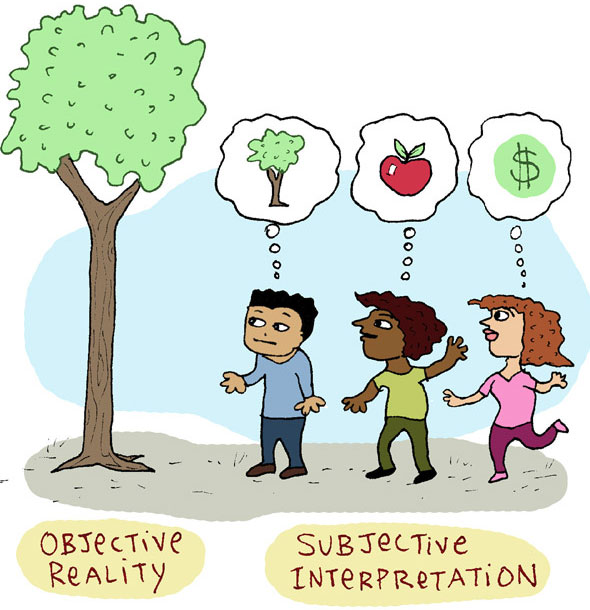
Mark Carney’s central point in these first two chapters is that subjective value which is flawed. And that subjective value, in the form of the market economy, has permeated every facet of life turning everything into an economist’s calculation and taking the relationships and intangible value for granted.
Oscar Wilde’s “the price of everything and the value of nothing” is Carney’s central critique of subjective value..
This concept that money is a proxy for value is an obvious one but it is worth repeating. If the economic value of a good is determined by the price in the market, then people start developing the classic capitalist critic which continues to be attractive, especially for folks who aren’t interested in economics and instead think that capitalism is merely luck-based gambling coupled with inequality in the form of accruing capital deployed with the reward of interest.

So, this is a complex topic. How do you measure value? Amazon rainforest is only valuable if you strip it of foliage. Amazon the company is valuable and on a ledger at $1.5 trillion equity valuation as of March 2021. Mark Carney believes we first need to understand how value was measured in these first two chapters.
Value in the economic theory distinguishes between value creation and value capture/extraction/rent seeking. Value theory has been explored by Aristotle (the “just price”), St. Thomas Aquinas talks about a just price + value capture and Dante says usury, interest or rent-seeking, are evils that send the issuer to the 7th ring of hell. The concept of interest is discussed on the basis of disutility (ie. opportunity cost). Disutility is the cost synergies of the absence of the thing i.e loss of profit = interest. If I lend you some land I own, then you should pay me interest. The word interest goes back to ancient humanity when it literally meant lamb. So I lend you my land then you pay me in lambs develop with you using that land….
Value at the nation state level was about trade routes, silver and the balance of payments ie. selling more things then you buy. Value perception changed as moving things around was how you made value in the mercantilist age of European empire building. Distribution was the valuable item itself.
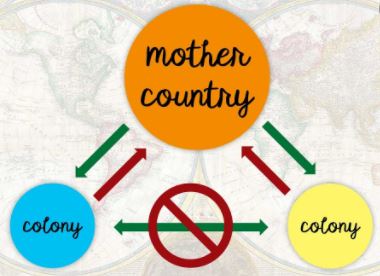
Mercantilism theory of “why a nation became rich” is perhaps today known as crony capitalism, according to Carney. Net export was the measure of value and the surplus was in the form of gold which was the measure of wealth. Gold and silver were the global currency and then banknotes were offered by central banks which we redeemable as gold or silver at that central bank with banknotes. The common good was in the name of nations, but the self interest was selective for those who were members of the mercantilist/crony capitalist class.
St Antonino (1389 – 1459) defined mercantilism. East Indian Company, a mercantilist company that ran India was responsible for half of all global trade in the mid-1700 to 1800s. Securing gold was the mechanism for measuring value for many centuries…value was measured in gold and silver. This was obviously flawed since a new gold mines would the debase gold as a proxy for value…
There are other thinkers Mark Carney calls on:
Davanzati (1529 – 1606) defined value in use versus value in exchange. Argued that gold had no value in use but value in exchange since it can be used to command other goods.
Sir William Petty (1623 – 1687) develops a theory of labour in Oliver Cromwell’s Commonwealth government that is the modern basis for gross domestic products, which is another heavily debated metric in economics because of its flaw in measuring value. Petty defines the natural price as the par value of land. This approach predates but also predicts Adam Smith’s approach. Petty was able to explain national production. The only thing that matters are merchant trades, clothing, food and housing. Lawyers have no value in this theory. Petty’s national account: the GDP, we use it as a compass today.

Physiocratic emerged as another way to look at value creation. The term is based on ‘government by nature’. Laissez-faire and wealth was solely from agriculture. Government by nature that value was derived solely from agriculture. Quesnay’s Tableau is the first to see the economy as a system and applied a systems-thinking approach. He also saw that exports generated gold which was the best measure of value they had at the time. Quesnay saw the farmers are the value creators, supported land is more important than the mercantilists in his view as the flag bearer for the Physiocratic movement. The problem with their approach was the industrial revolution was about to reveal that agriculture alone was indeed not the best way to measure the source of value.
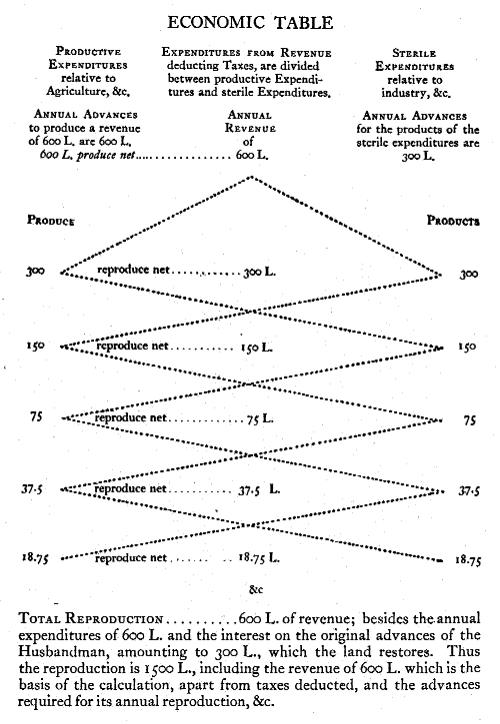
Richard Cantillon (1680 – 1734) who built on Quesnay’s ideas but he’s not that important. There are three heavy hitters that Carney addresses.
The biggest contributions to value measurement are the classists.
The Classists: Adam Smith, David Ricardo and Karl Marx. They shared three basic ideas:
- The Economy requires labour: The value of a good or service is determined by the inputs to create it, particularly labour.
- The Economy is dynamic / changes in labour and technology: workers, landlords, industrialists respond to changes in the real world. This process triggers value creation and changes its distribution model.
- The Economy is the process of exchange that affects trade: the process of exchange effects value creation and distribution, Ricardo focused on gains from exchange of foreign goods and Marx focused on value of work and income distribution. Smith was interested in the systems thinking like Quesnay.
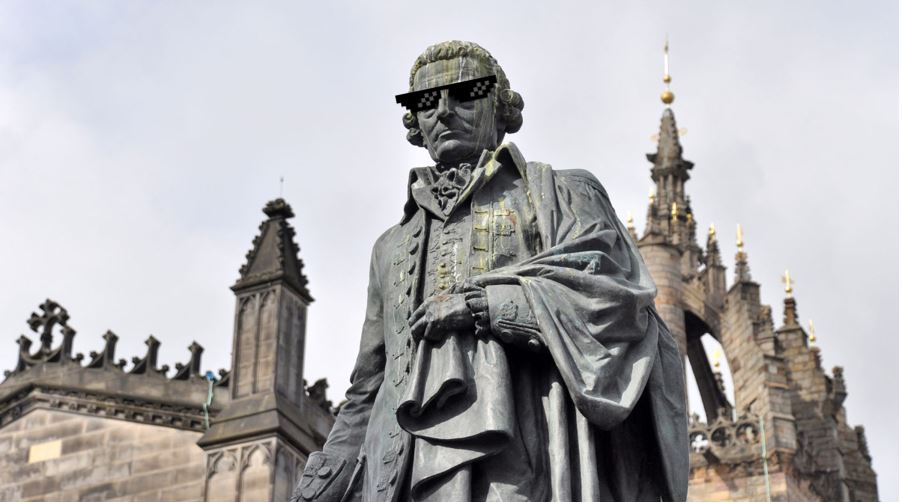
- Adam Smith (1723 – 1790)
Viewed as the father of modern economics, Smith (from Fife, Scotland) warned scholars about conflating money with economy and for good reason. He too knew that money was a proxy for value. The Wealth of Nation is the most owned economic text, least read (because it is not easy to read for today’s modern English standards) and is thus easily misinterpreted. Carney argues that Smith is loved by the left and right. For example, he is caricatured as the father of laissez faire capitalism despite the fact that the “invisible hand” appears only three times in any of his books and only twice in “An Inquiry into the Wealth of Nations” (1776), according to Jess Norman, Adam Smith: What He Thought, and Why it Matters (London: Allen Lane, 2018), pp21-2. What made him pan-ideological is that Adam Smith applied the scientific method to social scientific observation rather than ideological dogma. The ideological spectrum is a flawed generalization that gets dashed when it interacts with the unique circumstances that define any human interaction (but unfortunately, helps people simply/generalize and feel they know what’s going on, when in fact, ideology is a short-hand used to limit solution development). And as such, Smith was interested in understanding reality rather then bending it to any normative purposes.
Carney’s emphasis in talking about Adam Smith is on the fact that:
- Adam Smith was chiefly concerned with the idea that life involves continuous exchange.
- He believed that the desire to be loved and lovely led to a feedback of mutual cultural memes (Richard Dawkins-style)
- He famously exalted the fact that the butcher’s self interest (or self-love) got the meat on your table.
- He showed that social trust is the engine of prosperity.
- He would not have recognized modern financial, economic infrastructure but believed in the living system of his time.
- He expanded the physiocrat definition of value being solely from agriculture to the definition to industry which was also ground breaking.
- He was worried about industry capturing government officials.
- He was very critical of monopolies and value capture.
- He was critical of mercantilism/crony capitalism and thus he promoted free trade.
- He valued competition in the pin-factory example.
What was Adam Smith’s contribution to a Theory of Value?
For Carney, Adam Smith’s formal theory of value was unsuccessful. He, like the other classicists, argued that labour was the main source of value. Total value creation equals the time spent by workers on production taking into account quality and effort. Labour is the measure of exchange value of all commodities. For example, in a hunter only economy where one beaver is as hard to hunt as two deer, then the price of one beaver is two deer. The price of a good is usually therefore based on the relative ‘estimate’ of the labour to procure that good. But Smith didn’t touch on the fact that the act of valuing effects the three things Smith valued most in a functioning market: trust, fairness and integrity. Why does labour and price have such gaps then? Smith doesn’t understand and he didn’t resolve the gap between market prices (nominal/money price) and labour value (real price)….Ricardo and Marx would build on Smith’s work to answer this ‘gap’ problem..
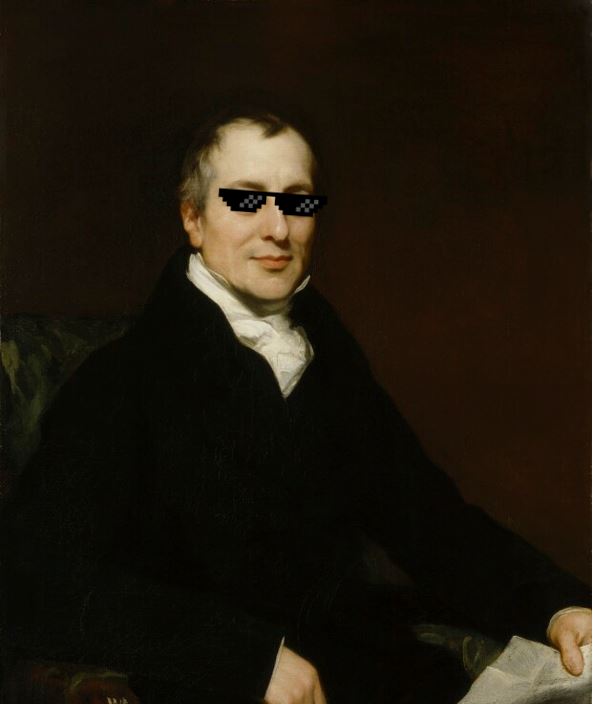
- David Ricardo (1772 – 1823)
Ricardo (from Liverpool Street / Spitalfields Markets area of London) made his money by speculating successfully in government bonds with a networth of £100 million in today’s terms. He bet on the outcome of the Battle of Waterloo and made a fortune. Then he promptly retired to his Gloucestershire estate to write.
Carney’s view is that David Ricardo made critical contributions to economic thought:
- Free trade makes sense through the argument of competitive advantage which is a core position in economic liberalism today. The competitive advantage of wine from Portugal versus England is the classic example, it’s true but not always as obvious. His idea has largely been accepted that it is better to trade with other regions of the world where they have a relative efficiency of production rather than to prop-up domestic producers in the name of economic nationalism. Countries ought to specialize and trade more was Ricardo’s view.
- The Corn Law which was a protectionist move to support English landlords and it received Ricardo’s aggressive critique in Essay on the Influence of a Low Price of Corn on the Profits of Stock (1815). He explained that increasing tariffs on grain imports increases the rents of landlords, decreases the profits of manufacturers and slowed the economy’s rate of growth.
- Smith and Ricardo aligned on the idea that imports increase exports and growth country-to-country. They both agree that consumers should seek the cheapest price for a good. Monopolies would only serve to create fat, happy management.
- Ricardo expanded on this free-trade view with the law of diminishing marginal returns. Here, Ricardo was arguing that more and more inputs into a fixed amount of land would lead to diminishing returns from that land. Therefore restricting foreign inputs would bring more marginal land into production and thus lessen capacity into new production, since grain prices would increase, manufacturing would decrease and landlord rents would increase (Ricardo wasn’t a big fan of landlords). The point was that landlords had the ear of the political elite, Ricardo had the ear of the economic engine.
What was David Ricardo’s contribution to a Theory of Value?
In Principles of Political Economy and Taxation (1817), Ricardo argues that labour theory of value; value depends on the labour for its production and not on the cost of that labour. The iron law of wages: wages rise and fall, profits fall and rise correspondingly. Profits grow….If the prices of food, agriculture is less productive then the profits decline. His Essay on Profits argues that profits depend on wages, wages on essentials and essentials then impact the price of feed. His theory of growth showed that profits grow, capitalists invest, expand manufacturing which created more and more jobs and wages. The price of food regulates wages.
Carney, and others, identify two problems with Ricardo. First, Ricardo doesn’t pay much attention to organizations of production (division of labour for example) instead focusing on monetary and fiscal areas which leaves an incomplete picture of value. Second, Ricardo labour theory of value doesn’t account for “differences in the time horizon of the returns to the various factors of production.” (page 35, Value(s)). He should have established a relationship between capital and labour as he had between land and labour wages. His solution of providing a value for capital as accumulated labour doesn’t really work since if you build a factory you would expect to be paid back over several years but if you worked in the factory you would get paid on a monthly basis….so the horizon of the worker is shorter than that of the capitalist. Marx would close off this problem of accounting for value through labour.
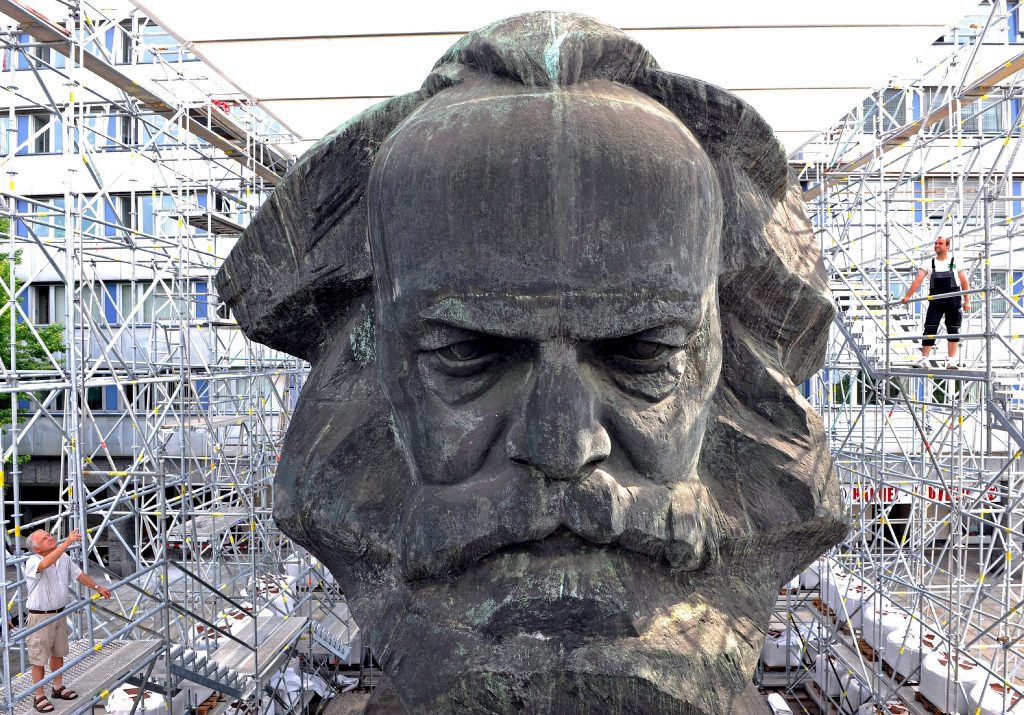
- Karl Marx (1818 – 1883)
Marx (Trier) was a Hegelian. He followed the dialectic model of thinking which for Marx revealed new truths and he had revised his writings to fit into oppositional forces as he doubled down on Hegel later in his writing. Marx is often mined by people to back their prior position. The Communist Manifesto (1848) and Das Kapital (1867) are well examined. Marx is the first economist you learn about in school and his name remains an adjective, a noun and a social theory because his ideas were used by various political actors to revolutionarily bend the bandwidth under which human nature operates. And the results were mixed, to be diplomatic about it.
What was Karl Marx’s contribution to a Theory of Value?
- Marx’s view on value, like Smith, centres on a social and political context.
- He sees that the history of society is a back and forth ie. Hegel’s idea.
- Marx was more explicit that production is a social activity that requires production.
- Production and distribution of value was critical for Marx.
- Regardless of changes in technology, the value of every good is determined by the labour to put it into production.
- He believed that every good has two values: useful value and exchange value.
- Like Smith and Ricardo, Marx saw labour at the centre of value but he also solved for the time horizon gap between labour and capital. The surplus value goes to the individuals who took the original risk to create the enterprise and then pay the labourers a subsistence wage and pocket the rest of the surplus value / the gap.
- Marx also argued that capitalists would replace labourers with machines if the cost of restoring labour power was above subsistence wages.
- Capitalism would overrun overtime the bargaining power of labour as they replaced labourers with machines and other automation..
- In his views, commercial speculative firms do not add value to capitalist production and by capturing the available surplus, capitalists do not re-invest in production but horde value for themselves as surplus.
- Labourers, who do not own the means of production, become alienated and then that surplus value is taken away.
The response to these three classists encapsulated the modern expression of how objective value is measured. However, Carney will show that value is measured subjectively. It is critical for Carney that we acknowledge how value measurement has been distorted over time so that we can then reset the system of measuring values for a better world for all…ambitious! To that end, Carney seems to recommend a return of these objective measures of value with hybrid additions from the likes of Carl Sunstein and others.
Analysis from Part 1 and Chapter 1
- Theory (9/10) versus Practice (5/10) Rating (out of 10): Theory is nice, these men were seeing the world from their own vantage point as we all do. Even Ricardo. Attempting to develop generalizable systems like a generalizable measure of value is kind of bunk, though. Anyone with a social science background will tell you predictability and perfectability aren’t what we humans are. There are pockets of predictability like “I am going to wake up today” but then there are less predictable things we do like “I am going to brush my teeth today…maybe.” The fact is there is no generalizable theory of human behaviour, folks. A bell-curve or overton window of human behaviour but it is evolving, alongside culture and many many variables. Human’s aren’t that predictable: that’s what makes us awesome!
- This chapter is a good primer on an economic theory of value. Not so much on an intangible theory of value which would be handy for climate change which comes up later.
- Subjective value is the target of his central criticism. Except, that objective value described in this book is accountant focused. It fails to measure the things we care about about like love. It’s only useful for economist minded people. Many people do not “value” economic thinking at all. And they have rights, preferences, influence on politicians hence the tendency to ignore capitalism in their personal and/or political decision-making.
- Ivy League Fallacy: some of the most theoretical and therefore impractical people graduate from Ivy League universities. Insulation from failure is also a major risk for Carney who doesn’t seem to notice he is detached as well. Mark Carney thinks he’s smart because he is smart but also he jumped through the hoops, he is not one for breaking the mold very much…It’s also possibly that I’m just jealous.
- Mark Carney believes that at the Bank of England which he joined in 2013 and his colleagues figured out “how to rebuild the social foundations of financial markets following the financial crisis in 2008” (page 28, Value(s)), I’m afraid that Senator Palpatine disagrees with you?…It just seems like a pretty grandiose claim.

- What about the concept of Networks in value creation? We buy and sell products and services from people who are top of mind. Adam Smith touches on this with the idea of being loved. If we have a good relationship with someone we work to support their goals. The labour put into helping someone we care about is a premium on that good or service.
- Who cares that Adam Smith was uncomfortable at Oxford? Well, a dude who went there himself. Balliol College, Oxford but the wizard hat sorter put Carney in Nuffield College….To be clear, I think Mark Carney has written an important book here, and he’s generally a unique voice in finance, but occasionally, he reveals some pretentious tendencies that Harvard and Oxford imbue in their students (“I am so smart because Oxford told me so”).
Citations Worth Noting for Part 1: Chapter 1:
- Marianna Mazzucato, The Value of Everything (London: Allen Lane, 2018), p. 6
- Sir William Petty, ‘The Political Anatomy of Ireland – 1672’, in A Collection of Tracts and Treatises Illustrative of the Natural History, Antiquities, and the Political and Social State of Iralen, vol II (Dublin: Alex. Thom & Sons, 1861), p 50.
- Jess Norman, Adam Smith: What He Thought, and Why it Matters (London: Allen Lane, 2018), pp. 21-2.
- David Ricardo, ‘Chapter 1: On Value’, in On the Principles of Political Economy and Taxation (1817): https://ww.marxists.org/reference/subject/economics/ricardo/tax/ch01.htm (accessed April 2021)
- Sir William Petty, ‘The Political Anatomy of Ireland – 1672’, in A Collection of Tracts and Treatises, vol. II (Dublin: Alex. Thom & Sons, 1861).

